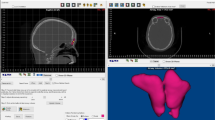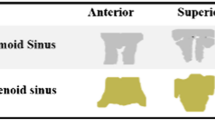Abstract
The uniqueness and reliability of frontal sinuses for personal identification have gained wide recognition in forensics. However, few studies have assessed the usefulness of a three-dimensional (3D) model of the frontal sinus for human identification. This study aimed to develop standardized techniques to classify the frontal sinus according to its 3D morphological metrics and discover the usefulness of the 3D frontal sinus model in identification of Chinese Han population. One hundred and ninety-six computed tomography (CT) scans of patients older than 20 years (84 males and 112 females) were collected. A 3D frontal sinus digital model was segmented using Dolphin Imaging software. The following morphological metrics of the 3D frontal sinus were used to develop the coding system: bilateral or unilateral, spatial relationships of the two sides, number of septations, superior volume side, the shape of the 3D model of each side, shape of the medial surface and frontal ostium on each side, number of accessory septations on each side, number of supra-orbital cells of the medial surface and lateral surface on each side, and number of the arcades on each side. The new coding system accurately identified all of our research individuals. This study discovered a number of individual variations in the 3D frontal sinus morphology patterns. A coding system, which is based on these morphological patterns, exposes the morphological variants of frontal sinuses and presents the usefulness of 3D frontal sinus model for human identification.



Similar content being viewed by others
Data availability
The data are not public.
References
Fatu C, Puisoru M, Rotaru M, Truta AM (2006) Morphometric evaluation of the frontal sinus in relation to age. Anna Anat 188(3):275–280. https://doi.org/10.1016/j.aanat.2005.11.012
Park IH, Song JS, Choi H, Kim TH, Hoon S, Sang HL, Heung ML (2010) Volumetric study in the development of paranasal sinuses by CT imaging in Asian: a pilot study. Int J Pediatr Otorhi 74(12):1347–1350. https://doi.org/10.1016/j.ijporl.2010.08.018
Silviya N, Diana T, Ivan G, Angel D, Nikolai L (2018) Morphometric analysis of the frontal sinus: application of industrial digital radiography and virtual endocast. J Forensic Radiol Imag 12:31–39. https://doi.org/10.1016/j.jofri.2018.02.001
Xavier TA, Dias Terada ASS, Da Silva RHA (2015) Forensic application of the frontal and maxillary sinuses: a literature review. J Forensic Radiol Imag 3(2):105–110. https://doi.org/10.1016/j.jofri.2DD015.05.001
Quatrehomme G, Fronty P, Sapanet M, Grvin G, Bailet P, Ollier A (1986) Identification by frontal sinus pattern in forensic anthropology. Forensic Sci Int 83(2):147–153. https://doi.org/10.1016/S0379-0738(96)02033-6
Holobinko A (2012) Forensic human identification in the United States and Canada: a review of the law, admissible techniques, and the legal implications of their application in forensic cases. Forensic Sci Int 222(1):394.e1-.e13. https://doi.org/10.1016/j.forsciint.2012.06.001
Campobasso CP, Dell'Erba AS, Belviso M, Di VG (2007) Craniofacial identification by comparison of antemortem and postmortem radiographs: two case reports dealing with burnt bodies. Am J Foren Med Path 28(2):182–186. https://doi.org/10.1097/PAF.0b013e31806195cb
Brun CN, Christensen AM, Kravarski M, Gorincour G, Schweitzer W, Thali MJ, Gascho D, Hatch GM, Ruder TD (2017) Comparative radiologic identification with standardized single CT images of the paranasal sinuses—evaluation of inter-rater reliability. Forensic Sci Int 280:81–86. https://doi.org/10.1016/j.forsciint.2017.08.029
Taniguchi M, Sakoda S, Kano T, Zhu BL, Maeda H (2003) Possible use of nasal septum and frontal sinus patterns to radiographic identification of unknown human remains. Osaka City Med J 49(1):31–38
Silva RFD, Prado FB, Caputo IGC, Devito KL, Botelho TDL, Eduardo DJ (2009) The forensic importance of frontal sinus radiographs. J Forensic Legal Med 16(1):18–23. https://doi.org/10.1016/j.jflm.2008.05.016
Tatlisumak E, Ovali GY, Aslan A, Asirdizer M, Zeyfeoglu Y, Tarhan S (2007) Identification of unknown bodies by using CT images of frontal sinus. Forensic Sci Int 166(1):42–48. https://doi.org/10.1016/j.forsciint.2006.03.023
Yoshino M, Miyasaka S, Sato H, Seta S (1987) Classification system of frontal sinus patterns by radiography. Its application to identification of unknown skeletal remains. Forensic Sci Int 34(4):289–299. https://doi.org/10.1016/0379-0738(87)90041-7
Cameriere R, Scendoni R, Lin Z, Milani C, Palacio LAV, Turiello M, Ferrante L (2020) Analysis of frontal sinuses for personal identification in a Chinese sample using a new code number. J Forensic Sci 65(1):46–51. https://doi.org/10.1111/1556-4029.14135
Christensen A (2005) Testing the reliability of frontal sinuses in positive identification. J Forensic Sci 50(1):18–22. https://doi.org/10.1520/JFS2004145
Cox M, Malcolm M, Fairgrieve SI (2009) A new digital method for the objective comparison of frontal sinuses for identification. J Forensic Sci 54(4):761–772. https://doi.org/10.1111/j.1556-4029.2009.01075.x
Souza LAD, Marana AN, Weber SAT (2018) Automatic frontal sinus recognition in computed tomography images for person identification. Forensic Sci Int 286:252–264. https://doi.org/10.1016/j.forsciint.2018.03.029
Wang JJ, Wang JL, Chen YL, Li WS (2012) A post-processing technique for cranial CT image identification. Forensic Sci Int 221(1–3):23–28. https://doi.org/10.1016/j.forsciint.2012.03.019
Bassam H, Paul VDS, Gerard S (2008) Accuracy of three-dimensional measurements obtained from cone beam computed tomography surface-rendered images for cephalometric analysis: influence of patient scanning position. Eur J Orthodont 31(2):129–134. https://doi.org/10.1093/ejo/cjn088
Kushwah A, Bhalse R, Pande S (2015) CT evaluation of diseases of paranasal sinuses & histopathological studies. Int J Med Res Rev 3:1306–1310. https://doi.org/10.17511/ijmrr.2015.i11.237
Yüksel Aslier NG, Karabay N, Zeybek G, Keskinoğlu P, Kiray A, Sütay S, Ecevit MC (2016) The classification of frontal sinus pneumatization patterns by CT-based volumetry. Surg Radiol Anat 38(8):923–930. https://doi.org/10.1007/s00276-016-1644-7
Wanzeler AMV, Alves-Júnior SM, Ayres L, da Costa Prestes MC, Gomes JT, Tuji FM (2019) Sex estimation using paranasal sinus discriminant analysis: a new approach via cone beam computerized tomography volume analysis. Int J Legal Med 133(6):1977–1984. https://doi.org/10.1007/s00414-019-02100-6
Čechová M, Dupej J, Brůžek J, Bejdová Š, Horák M, Velemínská J (2019) Sex estimation using external morphology of the frontal bone and frontal sinuses in a contemporary Czech population. Int J Legal Med 133(4):1285–1294. https://doi.org/10.1007/s00414-019-02063-8
Choi IGG, Duailibi-Neto EF, Beaini TL, da Silva RLB, Chilvarquer I (2018) The frontal sinus cavity exhibits sexual dimorphism in 3D cone-beam CT images and can be used for sex determination. J Forensic Sci 63(3):692–698. https://doi.org/10.1111/1556-4029.13601
Gibelli D, Cellina M, Cappella A, Gibelli S, Panzeri MM, Oliva AG, Termine G, De Angelis D, Cattaneo C, Sforza C (2019) An innovative 3D-3D superimposition for assessing anatomical uniqueness of frontal sinuses through segmentation on CT scans. Int J Legal Med 133(4):1159–1165. https://doi.org/10.1007/s00414-018-1895-4
Beaini TL, Duailibi-Neto EF, Chilvarquer I, Melani RFH (2015) Human identification through frontal sinus 3D superimposition: pilot study with cone beam computer tomography. J Forensic Legal Med 36:63–69. https://doi.org/10.1016/j.jflm.2015.09.003
Cappella A, Gibelli D, Cellina M, Mazzarelli D, Oliva AG, De Angelis D, Sforza C, Cattaneo C (2019) Three-dimensional analysis of sphenoid sinus uniqueness for assessing personal identification: a novel method based on 3D-3D superimposition. Int J Legal Med 133(6):1895–1901. https://doi.org/10.1007/s00414-019-02139-5
Kim DI, Lee UY, Park SO, Kwak DS, Han SH (2013) Identification using frontal sinus by three-dimensional reconstruction from computed tomography. J Forensic Sci 58(1):5–12. https://doi.org/10.1111/j.1556-4029.2012.02185
Krus BS (2014) 3D CBCT analysis of the frontal sinus and its relationship to forensic identification. Diss
Gibelli D, Cellina M, Gibelli S, Oliva AG, Termine G, Sforza C (2020) Are coding systems of frontal sinuses anatomically reliable? A study of correlation among morphological and metrical features. Int J Legal Med 134(5):1897–1903. https://doi.org/10.1007/s00414-020-02293-1
Figueroa RE (2016) Radiologic anatomy of the frontal sinus. In: Kountakis SE, Senior BA, Draf W (eds) The Frontal Sinus. Springer Berlin Heidelberg, Berlin, Heidelberg, pp 35–44
Guerram A, Minor JML, Renger S, Bierry G (2014) Brief communication: the size of the human frontal sinuses in adults presenting complete persistence of the metopic suture. Am J Phys Anthropol 154(4):621–627. https://doi.org/10.1002/ajpa.22532
Tang JP, Hu DY, Jiang FH, Yu XJ (2019) Assessing forensic applications of the frontal sinus in a Chinese Han population. Forensic Sci Int 183(1-3):104.e1-104.e3. https://doi.org/10.1016/j.forsciint.2008.10.017
Code availability
There is no code for software.
Funding
This work was supported by the Post-doctoral Research and Development Fund of Sichuan University (20826041D4013).
Author information
Authors and Affiliations
Corresponding authors
Ethics declarations
Conflict of interest
The authors declare that they have no conflict of interest.
Consent to participate
The present study was performed with the approval of the ethics committee of the West China Hospital of Sichuan University. Informed consent was obtained from all the patients.
Consent for publication
All the authors consent for the publication.
Additional information
Publisher’s note
Springer Nature remains neutral with regard to jurisdictional claims in published maps and institutional affiliations.
Rights and permissions
About this article
Cite this article
Zhao, H., Li, Y., Xue, H. et al. Morphological analysis of three-dimensionally reconstructed frontal sinuses from Chinese Han population using computed tomography. Int J Legal Med 135, 1015–1023 (2021). https://doi.org/10.1007/s00414-020-02443-5
Received:
Accepted:
Published:
Issue Date:
DOI: https://doi.org/10.1007/s00414-020-02443-5




